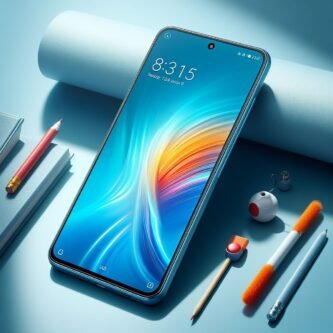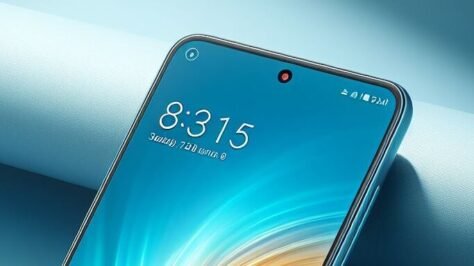Note: You can enhance and unlock Redmi Note 13 Pro’s hidden settings and functions by simply going through our comprehensive safe and 100% Authentic Rooting Guide
Xiaomi’s highly acclaimed Redmi Note series is back and redefines the smartphone experience like never before. With the cutting-edge Redmi Note 13 Pro 5G, we proudly present an extraordinary device that offers a remarkable 200-megapixel camera, convenient e-SIM support, and the option for ample storage capacity. Allow us to delve into the depths of this exceptional mid-tier phone through our comprehensive review, shedding light on whether it truly warrants a resounding purchase recommendation.
In 2024, the Redmi Note series expands with five new models, ranging from the budget-friendly Redmi Note 13 4G, priced under £200, to the premium Redmi Note 13 Pro+ 5G, costing around £400. Over the years, Redmi Note smartphones have gained a reputation as excellent midrange alternatives, offering a modern design, impressive cameras, and a premium AMOLED display at competitive prices.
In this review, our focus is on the Xiaomi Redmi Note 13 Pro 5G, the second most expensive model in the 2024 series with a manufacturer’s price of approximately £340. While it falls short of the top-tier model in terms of processing speed, charging capabilities, display curvature, and water and dust protection, the question remains: Does the Redmi Note 13 Pro 5G still present a compelling bargain?
Xiaomi Redmi Note 13 Pro 5G
Here’s a summary of the key specifications for the Xiaomi Redmi Note 13 Pro 5G:
- Processor: Qualcomm Snapdragon 7s Gen 2, 8 x 2 – 2.4 GHz, Cortex-A78 / A55
- Graphics adapter: Qualcomm Adreno 710
- Memory: 8 GB RAM
- Display: 6.67-inch AMOLED, 20:9 aspect ratio, 2712 x 1220 pixels, 446 PPI, 240Hz sampling rate, Gorilla Glass Victus, HDR, 120 Hz refresh rate
- Storage: 256 GB UFS 2.2 Flash, with 200 GB of free space
- Connectivity: USB 2.0, USB-C Power Delivery (PD), Infrared, 3.5mm audio port, Fingerprint Reader, NFC, accelerometer, gyro, proximity, compass sensors
- Networking: Wi-Fi 802.11 a/b/g/n/ac, Bluetooth 5.2, 2G/3G/4G/5G, Dual SIM, GPS
- Size: 161.2 x 74.3 x 8 mm
- Battery: 5100 mAh Lithium-Polymer, 67-watt fast charging
- Operating System: Android 13
- Camera:
- Primary Camera: 200 MP, f/1.65, phase comparison-AF, OIS, LED-flash, 8.0MP wide-angle lens, 2.0MP macro lens
- Secondary Camera: 16 MP, f/2.4
- Additional features: Stereo speakers (hybrid), silicone bumper, charger, USB cable, SIM tool, 24 Months Warranty, IP54-certified, e-SIM support, fanless
- Weight: 187 g
- Price: $431.18
Table of Contents
Note: Manufacturers may use components from different suppliers with similar specifications.
Here’s a comparison of the Xiaomi Redmi Note 13 Pro 5G with some possible competitors:
| Model | Rating | Date | Weight (g) | Storage | Size (inches) | Resolution | Best Price |
|---|---|---|---|---|---|---|---|
| Xiaomi Redmi Note 13 Pro 5G | 85.8% | 01/2024 | 187 | 256 GB UFS 2.2 | 6.67 | 2712×1220 | Not specified |
| Xiaomi Redmi Note 12 Pro 5G | 85.4% | 04/2023 | 187 | 128 GB UFS 2.2 | 6.67 | 2400×1080 | From $464.68 |
| Motorola Edge 40 Neo | 84.6% | 10/2023 | 170 | 256 GB UFS 3.1 | 6.55 | 2400×1080 | – |
| Sony Xperia 10 V | 83.1% | 09/2023 | 159 | 128 GB UFS 2.2 | 6.10 | 2520×1080 | – |
| Honor Magic5 Lite 5G | 82% | 05/2023 | 175 | 128 GB UFS 2.2 | 6.67 | 2400×1080 | From $400 |
Please note that “Best Price” for some models is not specified or available.
These ratings and specifications can help you compare the devices based on factors such as performance, features, and pricing. Consider your specific preferences and needs when making a decision.
Case – Slim bezels frame the screen
The Xiaomi Redmi Note 13 Pro 5G boasts a case design characterized by slim bezels framing its flat display, which lacks the curved edges seen in some other models. The overall construction feels solid and well-crafted, with a plastic frame and durable Gorilla Glass Victus protecting the screen.
Available in three color options—Black, soft violet, or greenish blue—the device’s matte glass back, particularly in the violet variant, resists fingerprints. The case exhibits resilience under pressure, maintaining its integrity without flexing or breaking.
Despite maintaining the same weight as its predecessor at 187 grams, the Redmi Note 13 Pro 5G manages to be more compact, implying a reduction in display bezel size. This design choice contributes to a premium aesthetic, especially notable in a phone within this price range.
The manufacturer claims IP54 dust and water protection, an improvement from the Redmi Note 12 Pro 5G. However, caution is still advised, and full immersion in water is not recommended despite the enhanced protection. Overall, the device’s design and build reflect a blend of aesthetics, durability, and practical features.
Size comparison based on the provided dimensions for the mentioned smartphones:
| Model | Dimensions (mm) | Weight (g) |
|---|---|---|
| Xiaomi Redmi Note 12 Pro 5G | 162.9 x 76 x 7.9 | 187 |
| Honor Magic5 Lite 5G | 161.6 x 73.9 x 7.9 | 175 |
| Xiaomi Redmi Note 13 Pro 5G | 161.2 x 74.3 x 8 | 187 |
| Motorola Edge 40 Neo | 159.6 x 72 x 7.8 | 170 |
| Sony Xperia 10 V | 155 x 68 x 8.3 | – |
| DIN A6 Paper | 105 x 148 (standard size) | – |
Please note that the weight for Sony Xperia 10 V and DIN A6 Paper is not provided.
These dimensions provide a clear comparison of the physical size of each smartphone, taking into account their height, width, and thickness. Keep in mind that weight can also influence the overall feel and handling of a device.
Features – Interesting details
The Xiaomi Redmi Note 13 Pro 5G comes with several interesting features:
| Memory Variants | Prices |
|---|---|
| 8 GB RAM / 256 GB mass storage | £339 |
| 12 GB RAM / 512 GB mass storage | £399 |
| Memory Controller | Details |
|---|---|
| LPDDR4X RAM | Equipped with LPDDR4X RAM |
| Supported RAM | Supports even faster LPDDR5 up to 6,400 MHz |
| Mass Storage | Details |
|---|---|
| UFS Version | UFS 2.2 flash |
| Performance | Performance details discussed in “Performance” section |
| Additional Features | Details |
|---|---|
| IR Blaster | Built-in IR blaster for remote control functionality |
| Audio Jack | 3.5mm audio jack for connecting analogue headphones or speakers |
| USB-C Port | Internally connected using USB 2.0 speed |
- While lacking a microSD reader, the device supports the use of 2 SIM cards and an e-SIM.
These details highlight the phone’s versatility, from ample storage options and memory configurations to practical features like the IR blaster and audio jack. The absence of a microSD reader is compensated by the support for dual SIM cards and e-SIM functionality.
Software – A ton of bloatware and security patches
The Xiaomi Redmi Note 13 Pro 5G comes with Xiaomi’s MiUI 14 user interface, built on Android 13. As of the review date, the security updates are current, with the latest being in January 2024. Xiaomi commits to providing three years of new Android versions and four years of security patches.
However, the phone comes with numerous preinstalled apps, taking up almost 50 GB of the device’s storage out of the box. While users have the option to delete or hide many of these apps, it can be time-consuming before achieving a relatively clean system. Although experienced users may find the inclusion of many security questions in advanced functions somewhat cumbersome, it could be beneficial for newcomers.
One notable drawback for a phone in this price range is the inclusion of advertisements in some of Xiaomi’s own apps. This can be perceived as an annoyance for users who expect a premium experience without intrusive ads. Despite this, the phone offers a feature-rich interface and regular updates, ensuring a modern and secure user experience over an extended period.
Communication and GNSS – Wi-Fi regression
The Xiaomi Redmi Note 13 Pro 5G supports WiFi 5, which is considered the fastest Wi-Fi standard for this smartphone’s wireless network connectivity. When tested with the Asus ROG Rapture AXE11000 reference router, the speeds were good and sometimes notably faster than some similarly-priced comparison phones. However, it’s important to note that the predecessor of this model, supporting WiFi 6, had slightly higher speeds.

Despite not fully leveraging a gigabit internet connection, the Redmi Note 13 5G still offers fast transfer speeds. Close proximity to the router ensures full reception strength, enabling rapid website loading. However, moving approximately 10 meters away with three walls in between results in 3/4 reception strength, causing a noticeable decrease in website loading speeds.
As a 5G smartphone, the Redmi Note 13 Pro 5G covers a wide range of frequencies, making it compatible for use in various European countries and even more distant locations. This flexibility enhances its connectivity and ensures users can benefit from 5G networks in regions with compatible infrastructure.
Networking
The provided information seems to be a comparison of networking performance, specifically using iPerf3, between different smartphones and the Asus ROG Rapture AXE11000 router, including results for both 5GHz and 6GHz bands. Here’s a summary of the key points:
Here’s the information presented in a structured format:
5GHz Band:
| Device | Receive | Transmit |
|---|---|---|
| Xiaomi Redmi Note 12 Pro 5G | 825 MBit/s (+138%) | 977 MBit/s (+44%) |
| Xiaomi Redmi Note 13 Pro 5G | 581 MBit/s (+67%) | 678 MBit/s (on par) |
| Honor Magic5 Lite 5G | 357 MBit/s (+3%) | 369 MBit/s (-46%) |
| Sony Xperia 10 V | 347 MBit/s (on par) | 363 MBit/s (-46%) |
6GHz Band:
| Device | Receive | Transmit |
|---|---|---|
| Motorola Edge 40 Neo | 668 MBit/s (-52%) | 878 MBit/s |
This table summarizes the 5GHz and 6GHz band performance for the mentioned devices, providing a clear overview of their receive and transmit speeds compared to the class average.
The percentages represent how each device’s performance compares to the average of the smartphone class over the last two years. It appears that the Xiaomi Redmi Note 12 Pro 5G outperforms the class average, especially in the 5GHz band, while the Redmi Note 13 Pro 5G performs well but not as high as its predecessor. The Honor Magic5 Lite 5G and Sony Xperia 10 V show mixed results in both bands. The Motorola Edge 40 Neo demonstrates good performance, especially in the 6GHz band.
The Xiaomi Redmi Note 13 Pro 5G demonstrates strong location capabilities, communicating with major satellite networks and achieving a commendable outdoor accuracy of up to 3 meters.
In a practical test focused on determining position accuracy during movement, the Redmi Note 13 Pro 5G was put to the test on foot, particularly in icy conditions. The Garmin Venu 2 smartwatch served as a comparison device, known for its reliable location capabilities.
The Redmi phone performed well, generally following the intended route accurately and deviating only occasionally. While the device can be utilized for navigation purposes, it was noted that there are more accurate location devices available. Despite this, the Redmi Note 13 Pro 5G proves to be a reliable option for determining location, especially in outdoor scenarios.
Telephone functions and voice quality – Sharp and clear
Xiaomi employs Google’s standard app for telephone calls on the Redmi Note 13 Pro 5G, offering users additional settings in the security app to facilitate the blocking of incoming calls.
During regular telephone calls, both the received audio and transmitted voices are reported to be very clear. However, it is advised not to speak too quietly, as the microphone may face challenges reproducing softer voices accurately.
When utilizing the speaker and hands-free microphone during calls, the quality remains similarly high. The recipient’s voice does not distort, even at maximum volume, and voices on the user’s end are clear, provided they speak at a reasonable volume. Overall, the calling experience on the Redmi Note 13 Pro 5G is reported to be of good quality, offering clear communication during regular calls as well as when using the speaker and hands-free functionality.
Cameras – The 200-megapixel camera takes decent photos
The Xiaomi Redmi Note 13 Pro 5G features a rear-facing 200-megapixel camera, which is often not fully utilized. Typically, the camera captures 12-megapixel photos, utilizing Samsung’s Isocell HP3 sensor that combines 16 pixels into one for improved light sensitivity. Accessing the maximum resolution requires a special mode, but good lighting conditions are necessary, and digital zoom is limited to 2x.
In standard mode, photos from the main camera could benefit from a bit more brightness, but overall, they are appealing in terms of detail and offer a nice bokeh effect. Under low-light conditions, the camera performs well, providing effective brightening. Sharpness is generally good, with only isolated parts of the image experiencing a reduction in quality.
The main camera supports 4K video recording at 30fps and 60fps in Full HD. The footage is reported to be good, with responsive and accurate autofocus and reliable adaptive brightness.
The 8-megapixel wide-angle camera captures decent snapshots, but sharpness diminishes towards the edges. Additionally, there is a low-resolution 2-megapixel macro camera.
The front-facing camera, with a maximum resolution of 16 megapixels, produces bright and detailed images.
In summary, the Redmi Note 13 Pro 5G’s camera system offers appealing photos, particularly in good lighting conditions, and supports video recording with satisfactory quality.
In the testing lab, the main camera of the Xiaomi Redmi Note 13 Pro 5G demonstrated sharpness in photos, but there were observations regarding contrast. In certain areas of the images, it was noted that the contrast could have been higher. Additionally, when capturing photos under low-light conditions at 1 lux, the colors appeared significantly darker.
These findings suggest that while the camera performs well in terms of sharpness, there may be room for improvement in contrast, especially in specific areas of images. The impact of low-light conditions on color representation is also highlighted. Overall, it indicates that the camera’s performance could vary under different lighting situations.
Accessories and warranty – A fast charger is included
Xiaomi has not compromised on accessories for the Redmi Note 13 Pro 5G, providing users with a comprehensive package. In addition to the 68-watt charger, the smartphone comes with a USB-C cable, a SIM tool, and a silicon case, enhancing the overall user experience.
Furthermore, for customers in Europe, Xiaomi offers a 24-month warranty with their devices, providing assurance and support for an extended period after the purchase. This inclusion of accessories and a generous warranty period adds value to the overall offering of the Redmi Note 13 Pro 5G.
Input devices & operation – A zippy touchscreen
The Xiaomi Redmi Note 13 Pro 5G features a 120 Hz display with a 240 Hz touchscreen sampling rate, contributing to a remarkably smooth smartphone operating experience. The display is reported to respond promptly to inputs, even at its corners and sides, ensuring a seamless and responsive interaction. The hardware buttons on the right-hand side of the case are noted to be reliable.
The phone’s fingerprint sensor is positioned beneath the display, and when the device is in standby mode, the corresponding area is highlighted. After a one-time fingerprint setup, unlocking the phone is quick and highly reliable. Additionally, the face recognition feature is quickly set up and functions flawlessly, providing users with multiple secure and convenient unlocking options.
Display – A very bright OLED screen
Xiaomi has a longstanding reputation for incorporating high-quality AMOLED displays in its midrange smartphones, and this tradition continues with the Xiaomi Redmi Note 13 Pro 5G. The AMOLED display on this device is highlighted as something special, with particular emphasis on its impressive brightness levels.
The display achieves high brightness levels of up to 1,205 cd/m² with a completely white screen and up to 1,345 cd/m² in smaller areas. This level of brightness not only enhances the overall viewing experience but also allows for excellent rendering of HDR content on the panel. Additionally, the phone caters to users who prefer reading in bed by providing the option to lower screen brightness, preventing excessively bright images that may cause discomfort in low-light conditions. Overall, the AMOLED display on the Redmi Note 13 Pro 5G is highlighted as a standout feature, offering vibrant visuals and adaptability to various user preferences.
| Brightness (cd/m²) | Column 1 | Column 2 | Column 3 |
|---|---|---|---|
| Row 1 | 1105 | 1153 | 1231 |
| Row 2 | 1126 | 1205 | 1211 |
| Row 3 | 1164 | 1189 | 1205 |
| MagiskHub | Xiaomi Redmi Note 13 Pro 5G | Xiaomi Redmi Note 12 Pro 5G | Motorola Edge 40 Neo | Sony Xperia 10 V | Honor Magic5 Lite 5G |
|---|---|---|---|---|---|
| Screen | AMOLED, 2712×1220, 6.67 | OLED, 2400×1080, 6.67 | pOLED, 2400×1080, 6.55 | OLED, 2520×1080, 6.10 | AMOLED, 2400×1080, 6.67 |
| Brightness middle | 1205 | 938 (-22%) | 966 (-20%) | 933 (-23%) | 846 (-30%) |
| Brightness | 1177 | 939 (-20%) | 957 (-19%) | 944 (-20%) | 853 (-28%) |
| Brightness Distribution | 90 | 96 (+7%) | 97 (+8%) | 97 (+8%) | 88 (-2%) |
| Black Level | – | – | – | – | – |
| Colorchecker dE 2000 | 1.51 | 0.9 (-40%) | 1.87 (+24%) | 1.1 (-27%) | 1.3 (-14%) |
| Colorchecker dE 2000 max. | 4.07 | 1.6 (-61%) | 4.34 (+7%) | 1.7 (-58%) | 2.7 (-34%) |
| Greyscale dE 2000 | 2.5 | 1 (-60%) | 2.5 (0%) | 1.8 (-28%) | 1.7 (-32%) |
| Gamma | 2.175 (101%) | 2.25 (98%) | 2.272 (97%) | 2.29 (96%) | 2.19 (100%) |
| CCT | 6407 (101%) | 6350 (102%) | 6582 (99%) | 6611 (98%) | 6570 (99%) |
| Screen flickering / PWM detected | 713.5 Hz |
The screen backlight flickers at a frequency of 713.5 Hz (for example, when using PWM).
This frequency is relatively high, making it unlikely that most users sensitive to PWM will perceive any flickering.
For comparison: 53% of all tested devices do not employ PWM for screen dimming. If PWM is detected, the average frequency measured is 18446 Hz (with a minimum of 5 Hz and a maximum of 3846000 Hz).
Performance – A meagre upgrade
The recently introduced Qualcomm Snapdragon 7s Gen 2 SoC bears a striking resemblance to last year’s Snapdragon 7 Gen 1.
During our benchmark tests, the processor consistently achieved top positions among devices with similar pricing. The Redmi Note 13 Pro 5G generally outperformed its predecessor, although the real-world impact of this difference in everyday use may be subject to debate. Nevertheless, our review device demonstrated smooth performance and provided ample power for handling moderately demanding applications.
| Geekbench 5.5 Single-Core | Average of class Smartphone (119 – 2138, n=216, last 2 years) | 891 Points (+34%) |
|---|---|---|
| Motorola Edge 40 Neo | MediaTek Dimensity 7030, Mali-G610 MP3, 12288 | 789 Points (+18%) |
| Xiaomi Redmi Note 13 Pro 5G | Qualcomm Snapdragon 7s Gen 2, Adreno 710, 8192 | 783 Points (+18%) |
| Average Qualcomm Snapdragon 7s Gen 2 | – | 783 Points (+18%) |
| Xiaomi Redmi Note 12 Pro 5G | MediaTek Dimensity 1080, Mali-G68 MP4, 8192 | 765 Points (+15%) |
| Sony Xperia 10 V | Qualcomm Snapdragon 695 5G, Adreno 619, 6144 | 669 Points (0%) |
| Honor Magic5 Lite 5G | Qualcomm Snapdragon 695 5G, Adreno 619, 6144 | 666 Points (0%) |
| Geekbench 5.5 Multi-Core | Multi-Core | Average of class Smartphone (473 – 6439, n=216, last 2 years) | Points | Change |
|---|---|---|---|---|
| Xiaomi Redmi Note 13 Pro 5G | Qualcomm Snapdragon 7s Gen 2, Adreno 710, 8192 | 2678 Points | +42% | 2858 |
| Motorola Edge 40 Neo | MediaTek Dimensity 7030, Mali-G610 MP3, 12288 | 2197 Points | +16% | 2678 |
| Xiaomi Redmi Note 12 Pro 5G | MediaTek Dimensity 1080, Mali-G68 MP4, 8192 | 2035 Points | +8% | 1921 |
| Sony Xperia 10 V | Qualcomm Snapdragon 695 5G, Adreno 619, 6144 | 1921 Points | +2% | 2035 |
| Honor Magic5 Lite 5G | Qualcomm Snapdragon 695 5G, Adreno 619, 6144 | 1891 Points | 0% | 1891 |
Concerning graphics performance, the recently introduced Adreno 710 delivers commendable scores, enabling the Redmi Note 13 Pro 5G to lead the competition. Even in demanding benchmarks, the device handled Full HD smoothly. However, it’s worth noting that the chipset’s capabilities fall short for higher resolutions.
| 3DMark / Wild Life Extreme Unlimited | Device | GPU | Storage | Points | Change |
|---|---|---|---|---|---|
| Xiaomi Redmi Note 13 Pro 5G | Adreno 710, SD 7s Gen 2, 256 GB UFS 2.2 Flash | 788 Points | +123% | 788 | |
| Motorola Edge 40 Neo | Mali-G610 MP3, Dimensity 7030, 256 GB UFS 3.1 Flash | 693 Points | +96% | 693 | |
| Xiaomi Redmi Note 12 Pro 5G | Mali-G68 MP4, Dimensity 1080, 128 GB UFS 2.2 Flash | 632 Points | +79% | 632 | |
| Sony Xperia 10 V | Adreno 619, SD 695 5G, 128 GB UFS 2.2 Flash | 353 Points | 0% | 353 | |
| Honor Magic5 Lite 5G | Adreno 619, SD 695 5G, 128 GB UFS 2.2 Flash | 352 Points | 0% | 352 |
| Jetstream 2 – Total Score | ||||
|---|---|---|---|---|
| Device | Browser | Total Score | Change | |
| Average Qualcomm Snapdragon 7s Gen 2 | – | – | 117.3 Points | +63% |
| Xiaomi Redmi Note 13 Pro 5G (Chrome 120) | – | Chrome 120 | 117.292 Points | +63% |
| Motorola Edge 40 Neo (Chrome 118) | – | Chrome 118 | 102.38 Points | +42% |
| Average of class Smartphone (21.2 – 351, n=168, last 2 years) | – | – | 101.8 Points | +42% |
| Sony Xperia 10 V (Chrome 116) | – | Chrome 116 | 78.167 Points | +9% |
| Xiaomi Redmi Note 12 Pro 5G (Chrome 111) | – | Chrome 111 | 71.873 Points | 0% |
| JetStream 2 |
Similarly, the UFS 2.2 storage in the Xiaomi Redmi Note 13 Pro 5G is among the fastest in its price range. This results in quicker loading, data transfer, and efficient completion of copying tasks.
| AndroBench 3-5 | Xiaomi Redmi Note 13 Pro 5G | Xiaomi Redmi Note 12 Pro 5G | Motorola Edge 40 Neo | Sony Xperia 10 V | Honor Magic5 Lite 5G | Average 256 GB UFS 2.2 Flash | Average of class Smartphone |
|---|---|---|---|---|---|---|---|
| AndroBench 3-5 | 5% | 17% | -38% | -39% | -5% | 20% | – |
| Sequential Read 256KB | 946.8 | 1008.8 (7%) | 1004.4 (6%) | 444.54 (-53%) | 486.17 (-49%) | 896 ? (-5%) | 1369 ? (45%) |
| Sequential Write 256KB | 808.2 | 865.59 (7%) | 930.9 (15%) | 438.02 (-46%) | 420.44 (-48%) | 729 ? (-10%) | 979 ? (21%) |
| Random Read 4KB | 239.2 | 241.83 (1%) | 279.5 (17%) | 175.72 (-27%) | 171.13 (-28%) | 224 ? (-6%) | 234 ? (-2%) |
| Random Write 4KB | 220.5 | 234.21 (6%) | 284.1 (29%) | 165.15 (-25%) | 149.12 (-32%) | 225 ? (2%) | 253 ? (15%) |
Games – Sometimes at 60fps
We also tested the Redmi smartphone by downloading some games to evaluate their performance. The device does not consistently reach 60fps in all settings, and achieving even higher framerates is challenging.
Nevertheless, by adjusting your expectations and opting for lower graphics settings, PUBG Mobile and Genshin Impact can be enjoyed at a relatively smooth 60fps. On the other hand, Diablo Immortal is limited to 30fps in all settings, but it runs smoothly. We assessed the frame rates using the GameBench software.
Both touchscreen and motion controls function seamlessly.
Emissions – Throttling is absent in the Redmi Note 13 Pro 5G
Temperature
During prolonged periods of high load, the Xiaomi Redmi Note 13 Pro 5G may become noticeably warm, but the maximum temperature of 43.4 °C is never critical in terms of heat.
The smartphone also demonstrated no issues in sustaining its performance over extended load periods. After 20 runs in the 3DMark stress test, we observed very similar scores to those recorded at the beginning.
| Temperature | Xiaomi Redmi Note 13 Pro 5G | Xiaomi Redmi Note 12 Pro 5G | Motorola Edge 40 Neo |
|---|---|---|---|
| Temperature (°C) | |||
| Max | 43.4 | 39.7 | 37.6 |
| Average | 40.4 | 35.4 | 38.4 |
| Temperature (°F) | |||
| Max | 110 | 103 | 100 |
| Average | 105 | 96 | 101 |
| Temperature (°C) | |||
| Max | 43.3 | 42.9 | 37.1 |
| Average | 40.4 | 37.1 | 39.8 |
| Temperature (°C) | |||
| Max | 43.2 | 39.8 | 37 |
| Average | 40.4 | 37 | 39 |
| Temperature (°C) | |||
| Max | 42.9 | 38.7 | 41.1 |
| Average | 38.7 | 35.3 | 38.3 |
| Temperature (°C) | |||
| Max | 25.5 | 24.4 | 23.8 |
| Average | 24.4 | 23.2 | 23.5 |
| Temperature (°C) | |||
| Max | 23.8 | 23.5 | 23.4 |
| Average | 24.4 | 23.2 | 23.5 |
- The average temperature for the upper side under maximal load is 40.4 °C (105 F), compared to the average of 32.7 °C (91 F) for devices in the class Smartphone.
- The maximum temperature on the upper side is 43.4 °C (110 F), compared to the average of 35 °C (95 F), ranging from 21.9 to 56 °C for the class Smartphone.
- The bottom heats up to a maximum of 42.9 °C (109 F), compared to the average of 33.8 °C (93 F).
- In idle usage, the average temperature for the upper side is 24.4 °C (76 F), compared to the device average of 32.7 °C (91 F).
3DMark Wild Life stress test
| 3DMark Wild Life Stress Test Stability | |||||
|---|---|---|---|---|---|
| Honor Magic5 | Sony Xperia 10 | Xiaomi Redmi | Xiaomi Redmi | Motorola Edge 40 | |
| Lite 5G | V | Note 12 Pro | Note 13 Pro 5G | Neo | |
| ————————————— | ————— | —————- | ————– | —————- | —————— |
| Adreno 619, SD 695 5G, 128 GB UFS 2.2 | 99.8% (0%) | 99.7% (0%) | 99.4% (0%) | 99.4% (0%) | N/A |
| Flash | |||||
| Mali-G68 MP4, Dimensity 1080, 128 GB | N/A | N/A | 99.4% (0%) | 99.6% (0%) | N/A |
| UFS 2.2 Flash | |||||
| Adreno 710, SD 7s Gen 2, 256 GB UFS | N/A | N/A | N/A | 99.7% (+1%) | N/A |
| 2.2 Flash | |||||
| Mali-G610 MP3, Dimensity 7030, 256 GB | N/A | N/A | N/A | N/A | 99.3% (0%) |
| UFS 3.1 Flash |
Speakers
The Redmi phone has speakers located on the bottom edge and near the headphone area. Overall, the sound quality is good and balanced without being too loud, even at the highest volume.
When listening to classical music, you can hear each instrument clearly. Pop music showcases clear vocals, and when watching movies, the dialogue is easy to understand. However, the sound effects could use a bit more depth, as the small speaker lacks bass.
For those looking for better sound quality, using headphones or external speakers through the 3.5mm port or Bluetooth 5.2 is recommended. The device supports various audio codecs, including Hi-Res codecs like LHDC or aptX HD.
| Audio Analysis | Xiaomi Redmi Note 13 Pro 5G | Honor Magic5 Lite 5G |
|---|---|---|
| Speaker Loudness | Average but good (78.2 dB) | Relatively loud (90.7 dB) |
| Bass 100 – 315 Hz | Nearly no bass, 20% lower than median | Nearly no bass, 29.1% lower than median |
| Linearity of Bass | Average (10.9% delta to prev. frequency) | Linear (6.1% delta to prev. frequency) |
| Mids 400 – 2000 Hz | Higher mids, 6.8% higher than median | Balanced mids, 3.9% away from median |
| Linearity of Mids | Linear (6.2% delta to prev. frequency) | Linear (4.7% delta to prev. frequency) |
| Highs 2 – 16 kHz | Balanced highs, 2.4% away from median | Higher highs, 7.1% higher than median |
| Linearity of Highs | Average (8.6% delta to prev. frequency) | Linear (6.2% delta to prev. frequency) |
| Overall 100 – 16,000 Hz | Average linearity (19.1% difference to median) | Average linearity (20.6% difference to median) |
Compared to Same Class:
- Xiaomi Redmi Note 13 Pro 5G: 17% better, 9% similar, 74% worse.
- Honor Magic5 Lite 5G: 28% better, 9% similar, 63% worse.
Compared to All Devices Tested:
- Xiaomi Redmi Note 13 Pro 5G: 39% better, 7% similar, 53% worse.
- Honor Magic5 Lite 5G: 49% better, 8% similar, 43% worse.
Battery life – Quick charging and good staying power
Power consumption
In terms of energy efficiency, the Xiaomi Redmi Note 13 Pro 5G falls in the middle among its peers. While its basic power consumption is somewhat high, the average consumption under normal use is relatively low. However, when the smartphone operates at full power, it can deplete the battery quite rapidly.
For recharging, the phone comes with a 67-watt charger, enabling a full charge in a maximum of 45 minutes. Notably, the Redmi device does not support wireless charging.
| Xiaomi Redmi Note 13 Pro 5G | Xiaomi Redmi Note 12 Pro 5G | Motorola Edge 40 Neo | Sony Xperia 10 V | Average Qualcomm Snapdragon 7s Gen 2 | Average of class Smartphone |
|---|---|---|---|---|---|
| Battery Capacity | 5100 mAh | 5000 mAh | 5000 mAh | 5000 mAh | – |
| Power Consumption | -15% | -11% | 11% | 0% | -13% |
| Idle Minimum | 1.3 | 0.99 (24%↓) | 1 (23%↓) | 0.56 (57%↓) | 1.3 (0%↓) |
| Idle Average | 1.4 | 2.03 (45%↓) | 1.2 (14%↓) | 0.91 (35%↓) | 1.4 (0%↓) |
| Idle Maximum | 1.6 | 2.08 (30%↓) | 1.3 (19%↓) | 0.98 (39%↓) | 1.6 (0%↓) |
| Load Average | 2.5 | 3.97 (59%↓) | 5.2 (108%↑) | 5.34 (114%↑) | 2.5 (0%↓) |
| Load Maximum | 9.1 | 5.85 (36%↑) | 9.2 (1%↑) | 5.46 (40%↑) | 9.1 (0%↓) |
| Battery Life |
Battery Life
The Redmi Note 13 Pro 5G comes with a slightly larger battery compared to its predecessor, boasting a capacity of 5,100 mAh. This upgrade translates to a commendable runtime of 16 hours and 42 minutes in our Wi-Fi test, maintaining a consistent display brightness of 150 cd/m².
However, when subjected to heavy usage, the phone exhibits slightly lower efficiency compared to other devices in its price range. Despite this, the smartphone manages to support gaming or running resource-intensive applications for approximately 5 hours.
In day-to-day activities, the overall impressive battery life, coupled with rapid charging capabilities, ensures users need not worry about running out of battery quickly.
| Battery Runtime | Duration |
|---|---|
| Idle (without WLAN, min brightness) | 29h 46min |
| WiFi Websurfing | 16h 42min |
| Big Buck Bunny H.264 1080p | 19h 02min |
| Load (maximum brightness) | 5h 07min |
| Battery Capacity (mAh) | Xiaomi Redmi Note 13 Pro 5G | Xiaomi Redmi Note 12 Pro 5G | Motorola Edge 40 Neo | Sony Xperia 10 V | Honor Magic5 Lite 5G |
|---|---|---|---|---|---|
| 5100 mAh | 5000 mAh | 5000 mAh | 5000 mAh | 5100 mAh | |
| Battery Runtime | |||||
| -6% | 1786 | 1598 -11% | 2444 37% | 4067 128% | -19% |
| Reader / Idle | |||||
| 12% | 1142 | 1043 -9% | 1232 8% | 1615 41% | |
| H.264 | |||||
| 53% | 1002 | 978 -2% | 864 -14% | 1157 15% | 816 -19% |
| WiFi v1.3 | |||||
| -19% | 307 | 299 -3% | 355 16% | 388 26% |
Verdict – The midrange smartphone exhibits minor drawbacks
In early 2024, Xiaomi raises the bar for midrange smartphones with the Redmi Note 13 Pro 5G. It boasts a bright AMOLED display, a high-resolution camera, a lightweight and slim design with Gorilla Glass Victus protection, ample storage options (up to 512 GB UFS 2.2 flash), a 3.5mm audio jack, an IR blaster, and now supports e-SIM.
However, the Wi-Fi speed is noticeably slower than its predecessor, and the software experience is mixed, with an expanded update policy but an abundance of preinstalled third-party apps. The main camera delivers decent photos, selfies are good, and the phone offers acceptable location accuracy and voice quality.
Despite its plastic case, the Redmi Note 13 Pro 5G stands out as a premium midrange smartphone with no significant weaknesses. Its predecessor, the Redmi Note 12 Pro 5G, is more budget-friendly but has some compromises. The Motorola Edge 40 Neo, priced similarly, impresses with an even faster display and Wi-Fi.
Price and availability
As of the review, the Xiaomi Redmi Note 13 Pro 5G with 256 GB of mass storage is available on Amazon UK for $377, and it is listed as an Amazon exclusive.
| Category | Score |
|---|---|
| Chassis | 85% |
| Keyboard | 65% |
| Pointing Device | 93% |
| Connectivity | 52% |
| Weight | 89% |
| Battery | 91 / 86 → 100% |
| Display | 93% |
| Games Performance | 49% |
| Application Performance | 78 / 90 → 87% |
| Temperature | 88% |
| Noise | 100% |
| Audio | 69% |
| Camera | 75% |
| Average | 79% |
Transparency

The device used for this review was provided as a loan by the manufacturer or a shop for review purposes. The lender did not influence this review, and the manufacturer did not receive a copy of the review before publication. There was no obligation to publish this review.
Download Section
- Magisk Manager Latest Version (Download )
- SDK Platform Tool ( Download )
- TWRP Recovery ( Download)
- SafetyNet Fix Magisk Module ( Download)
- Dolby Atmos Magisk Module ( Download)
- God-Speed Magisk Module ( Download)
- NL-Sound Magisk Module ( Download)
Official Magisk Owner : https://github.com/topjohnwu/Magisk
Disclaimer: Rooting your Android device is a complex process that can void your warranty, brick your device, and expose you to security risks. This content is for informational purposes only, and we take no responsibility for any consequences of your actions. Proceed at your own risk.




